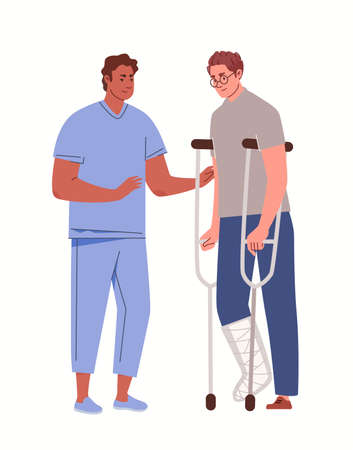Understanding NHS Physiotherapy Services
Physiotherapy is a crucial part of the healthcare services provided by the NHS, aimed at helping individuals manage pain, restore movement, and improve physical function following injury, illness, or disability. Within the NHS framework, physiotherapy is delivered by highly trained professionals who use evidence-based techniques such as exercise therapy, manual therapy, and education to assist patients in their recovery. NHS physiotherapy services cater to a wide range of conditions, including musculoskeletal problems like back pain and sports injuries, neurological disorders such as stroke or Parkinson’s disease, and chronic respiratory issues like COPD. Typically, eligibility for NHS physiotherapy is determined based on clinical need rather than ability to pay; this means anyone registered with a GP in the UK can potentially access these services if their condition warrants it. However, access routes and waiting times can vary depending on local Clinical Commissioning Groups (CCGs) and service demand. The focus remains on supporting people to maintain independence and quality of life through tailored rehabilitation programmes that reflect individual goals and circumstances.
2. Determining If You Need Physiotherapy
Recognising when physiotherapy might be appropriate is an important first step before seeking a referral through the NHS. Physiotherapy in the UK is commonly recommended for a range of musculoskeletal, neurological, and respiratory conditions, as well as for rehabilitation following surgery or injury. Below is a structured guide to help you assess your symptoms or situation and determine whether physiotherapy may be suitable:
Common Symptoms and Conditions Indicating Physiotherapy
| Symptom/Condition | Description | Typical Presentation in the UK |
|---|---|---|
| Back or Neck Pain | Pain, stiffness, or limited movement in the spine area. | Often linked to sedentary work environments, poor posture, or minor injuries. |
| Sports Injuries | Strains, sprains, or overuse injuries related to physical activity. | Frequent among amateur footballers, runners, and cyclists. |
| Arthritis | Joint pain, swelling, and decreased mobility. | Osteoarthritis and rheumatoid arthritis are common among older adults in the UK. |
| Post-Surgical Rehabilitation | Recovery after operations such as knee or hip replacements. | NHS patients often receive physiotherapy to regain function and mobility post-op. |
| Breathing Difficulties | Shortness of breath or reduced lung capacity. | Seen in patients with COPD or recovering from chest infections. |
| Neurological Conditions | Difficulties with movement or balance due to stroke, MS, etc. | NHS physiotherapists commonly support long-term management plans. |
When Should You Consider Physiotherapy?
- If pain or discomfort limits your daily activities (e.g., walking, working, household tasks)
- If you have ongoing symptoms despite rest or over-the-counter treatments
- If you experience recurring injuries or persistent muscle/joint problems
- If you’re recovering from surgery and need support regaining strength and mobility
- If a GP, consultant, or other healthcare professional has suggested physiotherapy could benefit your condition
Important Note:
You do not need to wait until symptoms are severe. Early intervention can prevent further deterioration and speed up recovery. In the UK context, it’s common to initially discuss symptoms with your GP who will assess if physiotherapy is clinically appropriate before making an NHS referral. Self-referral may also be available in some areas—check with your local NHS Trust for specific pathways.

3. Consulting Your GP: The Referral Process
Step-by-Step Guide to Securing a Physiotherapy Referral
Approaching your GP for a physiotherapy referral through the NHS is a straightforward process, but being well-prepared can ensure you get the most out of your appointment. Here’s what you should know and do at each stage:
1. Book an Appointment with Your GP
The first step is to contact your local GP surgery to schedule an appointment. You may be able to book online, over the phone, or via the NHS App, depending on your practice’s systems.
2. Prepare Relevant Information
Before your appointment, take some time to note down important details about your condition. Include when your symptoms started, how they have progressed, any activities that worsen or alleviate your discomfort, and what self-care measures you’ve already tried. Being specific helps your GP assess whether physiotherapy is appropriate for you.
3. Discuss Your Symptoms Clearly
During the consultation, describe your symptoms concisely and honestly. Don’t hesitate to mention how your condition affects daily life or work. This context is valuable for your GP when considering a referral.
4. Ask About Treatment Options
Your GP will likely discuss various options with you, which may include home exercises, medication, or seeing a specialist such as a physiotherapist. If you feel physiotherapy would benefit you, express this clearly during your conversation.
5. What to Expect Next
If your GP agrees that physiotherapy is suitable, they will make a formal referral—either electronically or in writing—to an NHS physiotherapy service. You might receive information about waiting times and next steps at this stage. In some areas, GPs may also provide advice on self-referral schemes where available.
Key Points to Remember
Your GP acts as a gatekeeper within the NHS system and their clinical judgement guides referrals. Be prepared, open about your health needs, and proactive in seeking clarification if anything is unclear during the process.
4. Direct Access to NHS Physiotherapy
Direct access, or self-referral, is an increasingly available option in some parts of the UK, allowing patients to access physiotherapy services on the NHS without first seeing a GP. This pathway is designed to streamline care for musculoskeletal conditions and empower individuals to seek support more efficiently. However, availability varies depending on your location and local NHS Trust policies.
How Self-Referral Schemes Work
Self-referral schemes enable you to contact your local physiotherapy service directly—usually through an online form, telephone line, or sometimes by downloading and posting a referral form. You will typically provide details about your condition and symptoms. Depending on the information you give, you may be offered:
- An initial telephone assessment with a physiotherapist
- A face-to-face appointment if clinically appropriate
- Advice or self-management resources
Checking Availability in Your Area
Not all areas in the UK offer self-referral for physiotherapy. To find out if this service is available where you live, you should:
- Visit your local NHS Trust website and search for ‘physiotherapy self-referral’.
- Check with your GP practice—staff can often advise whether direct access is available locally.
- Use the NHS website’s service finder tool by entering your postcode.
Self-Referral Pathways: At a Glance
| Region/NHS Trust | Self-Referral Option? | Main Method | Contact Information |
|---|---|---|---|
| Greater Manchester | Yes | Online/Phone Form | NHS GM Trust Website |
| Birmingham & Solihull | No (GP referral required) | N/A | N/A |
| Bristol, North Somerset & South Gloucestershire | Yes | Online Portal/Phone | NHS BNSSG CCG Website |
| Kent & Medway | Varies by area | Check Local Website/GP Surgery | NHS Kent & Medway Website/Local GP Practice |
Important Considerations
If self-referral is not available in your area, you will need a GP referral as standard. Even where self-referral exists, certain groups—such as those with complex medical histories, neurological conditions, or children—may still require a traditional referral via their GP for safe and appropriate care. Always check local guidance before proceeding.
5. What Happens After Referral
Understanding NHS Physiotherapy Waiting Times
Once your GP or healthcare professional has referred you for physiotherapy through the NHS, it is important to be aware that waiting times can vary depending on your local Clinical Commissioning Group (CCG) and the urgency of your condition. In general, most patients can expect to wait anywhere from a few weeks up to several months for a first appointment. Priority is typically given to those with more acute or severe issues, while routine musculoskeletal problems may require longer waits. Some areas also offer self-referral schemes, which might slightly alter these timescales.
The Initial Assessment Process
Your first appointment will usually involve a thorough assessment carried out by a qualified NHS physiotherapist. This session is designed to understand your medical history, discuss the symptoms you are experiencing, and assess how your condition affects your everyday life. You may be asked detailed questions about your pain, mobility, and previous treatments. It’s common for the physiotherapist to conduct some physical tests—such as checking movement range, strength, and posture—to form an accurate diagnosis and begin planning your treatment pathway.
What to Expect During Your First Appointments
During your initial physiotherapy appointments with the NHS, you can expect a patient-centred approach tailored to your specific needs. The physiotherapist will explain their findings and work collaboratively with you to set realistic goals for recovery or symptom management. Treatment plans may include guided exercises, manual therapy, advice on self-management strategies, or referrals for additional support if needed. Sessions often involve practical demonstrations and recommendations for exercises to continue at home between appointments.
Follow-Up and Ongoing Support
Your progress will be monitored during subsequent visits, and adjustments to your treatment plan will be made as necessary. The number of sessions offered varies based on clinical need and local NHS resources. If you have concerns or notice changes in your symptoms between appointments, it’s important to communicate this with your physiotherapist to ensure you receive appropriate care.
6. Alternatives and Additional Support
While the NHS remains the primary route for physiotherapy referrals in the UK, it is important to recognise that there are alternative and supplementary options available, particularly if you are facing long waiting times or require more specialised care. Understanding these avenues can empower you to make informed decisions about your rehabilitation and well-being.
Private Physiotherapy
One of the most direct alternatives to NHS physiotherapy is seeking private treatment. Private clinics often offer shorter waiting times, flexible appointment scheduling, and a broader selection of therapies. You do not need a referral from your GP to access private services; you can self-refer and book directly with a clinic of your choice. However, costs vary significantly depending on location and the level of expertise required, so it is advisable to compare fees and check whether your health insurance provides any coverage for physiotherapy sessions.
Charitable Services
Several UK charities support people living with specific conditions—such as arthritis, neurological disorders, or chronic pain—and may provide access to free or subsidised physiotherapy or exercise classes. Organisations like Arthritis Action and the MS Society often offer tailored group sessions, advice lines, and educational resources that can complement traditional physiotherapy. Exploring these charitable services can be particularly valuable for ongoing management of long-term conditions.
Community Resources
Local councils and community centres frequently run physical activity programmes designed to support rehabilitation and general mobility. These might include group exercise classes, walking clubs, or specialist falls prevention courses led by trained instructors. Such initiatives can foster motivation through social engagement while providing practical support between formal physiotherapy appointments. Information about community resources is usually available from your local council website or through NHS Social Prescribing Link Workers attached to GP surgeries.
Integrating Alternative Support
It is worth noting that alternative options should be seen as complementary rather than replacements for NHS physiotherapy, particularly where complex medical issues are involved. Discussing your plans with your GP or NHS physiotherapist can help ensure continuity of care and prevent conflicting advice. By combining NHS treatment with private sessions, charity-led activities, or community programmes, many patients find they achieve more holistic and sustainable recovery outcomes.


